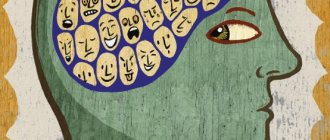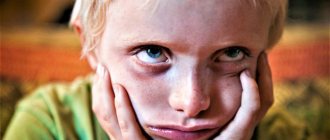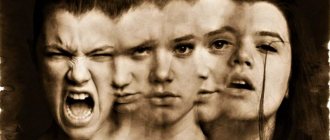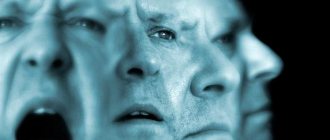Doctors say that severe physical illnesses occur in three stages:
- At the first stage, the body mobilizes all resources.
- On the second, balance arises, the body adapts to the disease.
- On the third stage, exhaustion sets in, the diseased organ (or the entire body) ceases to cope with the “work”.
The diagnosis and treatment of schizophrenia should be carried out by an experienced psychiatrist.
The course of schizophrenia resembles the course of serious illnesses of the body. There are three stages of schizophrenia: mastery, adaptation and degradation. The severity and duration of these stages vary significantly.
Initial stage of development of schizophrenia
To understand what the early stage of schizophrenia is, it is necessary to turn to the history of a person’s life, touching on his childhood, adolescence, and often adulthood. In the above article by P.B. Gannushkin, domestic psychiatrist, student of S.S. Korsakov and V.P. Serbsky, one can observe references to close relatives of patients who often have mental disorders that are “close to both health and disease, and yet are neither one nor the other.” In other words, the prodromal stage of schizophrenia often develops in an unfavorable psychological environment that is created and supported by family members.
Prodromal stage: family, childhood and adolescence
It is in the context of the family picture that the initial stage of schizophrenia acquires features characteristic of the disease. Otherwise, the psychopathological state of such a person, taken in isolation, can be attributed, for example, to manifestations of neurotic disorders, hypochondriacal reactions, depressive states, reactions to stress, character accentuations. Without access to family history, there is a high likelihood of diagnostic error and, as a result, the opportunity for early treatment of the first stage of schizophrenia is missed.
A pathological family environment, taking into account age characteristics, genetic predisposition and characteristics of a person’s mental constitution, can provoke the development of the initial stage of schizophrenia. The initial stage develops over a period of several years to several decades (A.V. Snezhnevsky).
The early stage of schizophrenia, as a rule, occurs latently (secretly) against the background of observation and assimilation of the experience of pathological relationships between family members, manifestations of their mental disorders (such manifestations are accepted by the child as the norm, since critical thinking has not been formed). Fears and phobias, neurotic and psychotic manifestations of family members leave an imprint on the child’s developing personality, distorting the picture of the world, strengthening defensive psychological reactions and ways of adapting to stressful situations.
“If psychosis...remains mild, the disease is extremely difficult to distinguish from bad character, immorality, capriciousness, false views of life” (W. Griesinger). In such cases, there is “... the construction of a new building from the task of the mind destroyed by the disease,” as a way of adapting to the outside world (V.F. Sabler).
The characteristic signs of the first stage of schizophrenia in men and women, manifested as a result of the development of latent or mild psychosis, include:
- isolation;
- unsociability;
- immersion in the inner world;
- reduced social activity;
- predominantly depressed state;
- frequent mood changes;
- behavior inappropriate to situations;
- hysterical reactions (eg, anger, tearfulness);
- emotional coldness;
- “loss” of feelings and emotions;
- loss of emotional connection with loved ones.
Pathological personality traits (schizophrenic defect) formed at the early stage of schizophrenia are often perceived by relatives and people around them as the traits of a “complex” person, psychopathic, neurotic, with exaggerated accentuations of character, infantilism or juvenileism. However, changes in personality in such people are directly related to completed mild or current latent psychosis, which must be understood, first of all, by family members.
Western and domestic psychiatrists spoke about ontogenetic factors, the schizophrenic constitution, predisposition to the disease and their influence on the development of the pathological process. Among them we can note such leading figures in the study of the early stages of schizophrenia as P.B. Gannushkin, W. Kretschmer, J. Wyrsch, J. Berze, E. Stransky.
Description of positive symptoms
Abnormal judgments and obsessions are noted at this stage. Schizophrenia causes a disorder of this kind against the will of the sick person. He can philosophize too much and conduct meaningless discussions on topics of an immense and global nature. The topic of conversation is often not only devoid of meaning, but also disordered in the style of narration, and there is a constant jumping from topic to topic. Positive signs of schizophrenia in women and men are accompanied by delusional states, motor and thinking disorders, and hallucinations.
Second (acute) stage of schizophrenia
For more than 100 years, there has been debate about defining the main forms of schizophrenia. Psychiatrists from different countries analyzed clinical cases and, based on common characteristics, introduced the corresponding names of syndrome complexes into circulation. Therefore, in various classifications of “psychiatric schools” of the early 20th century, one can find not only “classical” forms of schizophrenia according to E. Kraepelin (catatonic, hebephrenic, simple, paranoid), but also others.
The situation is similar today. If we compare more or less similar classifications of diseases - DSM, ICD and its adapted versions (for example, the domestic version of ICD-10), then we can find “additional” forms of schizophrenia that expand the boundaries of understanding the disease. However, with the introduction of ICD-11, the “classical” forms will be abolished, which will be replaced by variants of the course and stages of endogenous psychosis with dimensions and leading symptoms.
At the second stage of schizophrenia, under the influence of strong stress factors, the full picture of the disease unfolds - the so-called debut of schizophrenia occurs, usually with a predominance of symptoms of a specific form. It can occur in childhood, adolescence or adulthood. The later the onset occurs, the more favorable the prognosis for the treatment of schizophrenia.
It is at the acute stage of schizophrenia that one can observe clearly formed delusional ideas, signs of a distorted picture of the world and perception of reality, as well as personality traits that disrupt the social adaptation and process of communication of such a person with other people. A distinctive feature of the acute stage of schizophrenia is anosognosia - denial of the disease. Therefore, such people are usually hospitalized against their will.
Rice. 2. Types of distorted (delusional) perception of reality
Debut of schizophrenia: entry into adulthood, adulthood
There is no criticism of one’s own condition in the second stage of schizophrenia in men and women. Delusional pictures become structured and often look plausible and reasonable. It is impossible to convince such a person of the falsity of his formed views. Refuting crazy ideas with facts and rational explanations will not bring the desired result. Relatives need to understand that aggression, psychological pressure and violence towards such a person are unacceptable.
Delusional ideas and distorted pictures of the world in childhood and adolescence are unstructured, in contrast to well-formed ones in adults. With the onset of schizophrenia at an early age and, therefore, with timely psychopharmacotherapy and psychocorrection, it is possible to achieve stable remission; however, the same is true for adulthood, provided there is a prosperous work, social and family life before the onset of schizophrenia.
The characteristic features of the second stage of schizophrenia include:
- rave;
- hallucinations;
- thinking disorders;
- ambivalence of feelings;
- volitional defect;
- lethargy;
- passivity;
- emotional deficit;
- giving up hobbies that brought joy;
- avoiding contact with other people;
- slight excitability.
The psychotic state can go away on its own (spontaneous biological remission), last from several days to several months, or, left without treatment, become chronic. The behavior of a person in psychosis is unpredictable and cannot be explained. It is directly related to delusions and pseudohallucinations (for example, voices in the head can insult, give advice or order something to be done).
The disease at the second stage has different types of course. Moreover, flow types can replace each other. “Missed” psychosis, against the background of long-term biological remission, can cause a crisis after some time (months, years). In addition, if the disease proceeds sluggishly, it will in one way or another indirectly influence life in an unfavorable way - while the psychosis itself will remain unrecognized both by the person himself (“such a fate,” “that’s how they were raised”) and by his loved ones (“ complex character”, “life made me this way”).
Signs of psychosis development
Psychosis can occur suddenly or develop gradually. If the diagnosis is known, then it is possible to interrupt its development. Therefore, both the patient himself and his loved ones need to know about the first signs of the development of psychosis:
- poor sleep;
- anxiety;
- growing isolation.
Having missed the first signs of the development of psychosis, a person begins to lose touch with reality. His consciousness begins to be captured by delusional ideas; the picture of the world is perceived through paralogics. Relatives and acquaintances usually become involved in delusions (for example, jealousy, litigiousness, persecution), and become objects of hatred and aggressive behavior for such a person.
Rice. 3. Reasons for the development of a psychotic state
In adulthood and old age, at the second stage of schizophrenia, interpersonal conflicts arise, family quarrels, including with close and distant relatives, relationships at work, with friends and acquaintances deteriorate. Psychosis dramatically changes a person’s personality and the vector of his life in an unfavorable direction. At the same time, such a person can remain a good specialist in his field, be socially adapted and engage in everyday activities. In other words, it is important to understand that extreme forms of the disease are rare compared to its “socially adapted” forms.
With this diagnosis, you need to take medications for the rest of your life.
So far, the only effective way to combat schizophrenia is medication. During consultation with a psychiatrist, a treatment regimen is developed for each patient based on the use of appropriate psychotropic medications. After completing the prescribed course, the doctor assesses the patient’s condition and may allow a break. If favorable dynamics are observed after this, the doctor stops the medications.
Schizophrenia is a difficult test for a person. For such patients, outside support is important, and the myths that have taken root among people about this disease only complicate everything. Therefore, upon learning of the diagnosis, many become severely depressed and begin to think about suicide. Only professional help will help such patients adequately recognize the problem and set them up for recovery, since schizophrenia is treatable.
Make an appointment
Residual stage of schizophrenia
At the last stage of schizophrenia in men and women, negative symptoms come to the fore, positive ones lose intensity and become erased, or may simply be absent from the picture of the disease. In simple and hebephrenic forms of schizophrenia, such emotional and intellectual degradation occurs faster than in catatonic and paranoid ones. In terms of prognosis for treatment, the third stage is the most unfavorable. In rare cases, it is possible for such a person to return to society with a well-planned rehabilitation program, including work with relatives.
The last stage of schizophrenia is a persistent defect. Such a final state with pronounced negative symptoms should not be caused by dementia, other brain pathology, chronic depression, or hospitalization.
According to diagnostic guidelines, the last stage of schizophrenia must meet the following criteria:
- slow movements;
- speech poor in content and nuances;
- passivity, lack of initiative;
- “dull” emotional reactions;
- smoothed facial expressions;
- problems with self-care;
- "social autism".
Defect: personality, family, society
Without exception, all stages of schizophrenia are reflected in a person’s personality, his environment (primarily family members) and communication in society. Depending on the stage, such a person may have a “complex character” and cause aggression among relatives, even violent acts; or, on the contrary, “provoke” overprotection, against the background of which a “socially acceptable” form of the disease will develop. And thus, falling out of life in society in most cases does not occur due to “adaptation” at the second stage.
Before the debut of schizophrenia, the personality of such a person (his character, way of thinking, behavioral characteristics and reactions) is perceived by relatives and acquaintances within the normal framework, despite emerging interpersonal problems and conflicts. However, psychoses are not always pronounced and can be suppressed by loved ones until the onset of the last stage of schizophrenia, when it becomes simply impossible to deny the disease. Again, a defect can negatively affect a person’s life, but even here there are always options for “adaptation”, subject to the support of relatives, loved ones, and spouse.
Rice. 4. The final stage - personality defect
Considering the pathological family environment in which such people live, relatives often themselves suffer from prolonged stress, anxiety and depression, neurotic disorders, feelings of guilt and painful internal experiences. That is why, in addition to mandatory psychopharmacological treatment, measures are needed to restore harmony in the family, teach relatives how to behave correctly with such a person, how to provide him with help and support, and resolve their own internal conflicts.
Individual psychotherapeutic assistance to family members and family psychotherapy, even taking into account the formed pathological family stereotypes, can give results - stabilize the condition and improve the quality of life of both the person with a mental disorder and his family and friends.
Schizophrenics are dangerous to society due to cruelty and aggressiveness
This is also partly a myth. Many people have the impression that people with schizophrenia pose a threat to others. Mostly this is the negative influence of media and films. In fact, people with schizophrenia are as harmless as children. On the contrary, they themselves often become targets of criminal attacks.
A different scenario happens in the absence of proper treatment. Then, in the acute stage of the disease, a person is prone to violence under the influence of visions and delusional thoughts. It’s more scary when there are hallucinations of an auditory nature in the form of a call for specific hostile actions.
For example, in 2015, one resident of Nizhny Novgorod, during an exacerbation of schizophrenia, killed his own family (six children, wife and mother). He explained the action by saying that he heard an order to act in this way. Belov suffered from schizophrenia for a long time and repeatedly showed aggression towards his wife. Relatives tried to keep it a secret and did not seek help from doctors.
No less dangerous are delusional states associated with persecution mania. A person sees everyone and everything around him as a threat to himself. To protect himself, he often begins to defend himself from supposedly attacking people. Therefore, during an exacerbation of schizophrenia, relatives close to the patient are at greater risk.
References
1. Tiganov A.S. "Manual of Psychiatry".
2. Tiganov A.S. "Endogenous mental illnesses."
3. Snezhnevsky A.V. "Schizophrenia, a multidisciplinary study."
4. Snezhnevsky A.V. "Schizophrenia, a series of lectures."
5. Bleuler E. “The theory of schizophrenic negativism.”
6. Bleuler E. “Dementia Praecox or the Group of Schizophrenias.”
7. Kraepelin E. “Clinical psychiatry.”
8. Russian Society of Psychiatrists. "Federal clinical guidelines for the diagnosis and treatment of schizophrenia."
Description of negative symptoms
This group includes signs of schizophrenia with deeper emotional disorders. A person loses the ability to enjoy life. He falls into a depressed state or simply tries to protect himself from society. A neutral or bad mood is observed, but in rare cases the opposite manifestation occurs with an increase in mood. People with emotional disorders are not interested in the feelings of others. And they feel much more comfortable spending time alone. Schizophrenia manifests symptoms and signs of a negative type in the aspect of decreased sexual desire, ignoring hygiene rules, as well as alcohol consumption.
Cost of treatment in our clinic
| Service | Price | |
| Ambulatory treatment | ||
| Psychiatrist consultation | 4 500 ₽ | |
| Consultation with a psychotherapist | 4 500 ₽ | |
| Psychodiagnostics extended | 6 000 ₽ | |
| Consultation with a psychiatrist at home | 4 400 ₽ | |
| Treatment in hospital | ||
| Delivery to hospital | For free | |
| Standard room | 7 300 ₽ | |
| 3-bed superior room | 10 200 ₽ | |
| 2-bed superior room | 13 000 ₽ | |
| 1 local VIP chamber | 18 000 ₽ | |
| Doctor's appointment 2 weeks after discharge | For free | |
Description of cognitive symptoms
Cognitive signs are characterized by impairments in concentration and certain types of memory. A person cannot adequately plan, organize his own life, or make decisions. Schizophrenia exhibits symptoms and signs in the same way in women and men, but they are not always recognized as a medical history. It is possible to understand that these are disorders only with the help of neuropsychological tests. Schizophrenia can disguise symptoms as depression and psychosis. Tests allow you to find the truth.
Main types of disease
In the medical classification, the main types of schizophrenia include 9 positions. Some of them have subtypes. Experts identify several of them, which occur most often. Paranoid schizophrenia manifests itself in increased suspicion of others. A person is haunted by the feeling that he is constantly being watched, he has delusions and hallucinations. In the catatonic form of the disease there are movement disorders. And this can be either complete immobilization or chaotic disorderly excitement. Simple schizophrenia does not have a history of acute psychosis, but negative symptoms increase over time. The hebephrenic form manifests itself in the form of dementia and foolishness.
Myths and misconceptions
Behavior reveals signs of schizophrenia openly if you understand the specific manifestations of the disease. People with this diagnosis are considered non-violent and safe for society. This is not a myth, but we must take into account possible outbursts of rage and aggression, and unpredictable actions.
Personal failure and stupid behavior - this is also what others often say. Yes, certain stages of schizophrenia lead to this condition. A person can even behave like a child. There are forms of schizophrenia with not very pronounced symptoms. People in such cases are no more stupid than others in society. It is interesting that among people diagnosed with schizophrenia, there are many talented artists and musicians. A striking example is Vincent Van Gogh.











